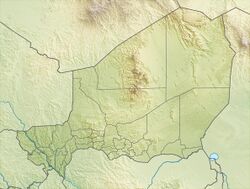Earth:Moradi Formation
| Moradi Formation Stratigraphic range: Lopingian ~259–252 Ma | |
|---|---|
| Type | Geological formation |
| Unit of | Izégouandane Group |
| Sub-units | Lower, Middle and Upper Units |
| Underlies | Teloua 1 Formation |
| Overlies | Tamamaït Formation |
| Thickness | 100 metres (330 ft) |
| Lithology | |
| Primary | Mudstone, siltstone |
| Other | Sandstone, conglomerate |
| Location | |
| Coordinates | [ ⚑ ] : 18°48′N 7°12′E / 18.8°N 7.2°E |
| Paleocoordinates | [ ⚑ ] 16°36′S 8°12′E / 16.6°S 8.2°E |
| Region | Agadez Region |
| Country | |
| Extent | Iullemmeden Basin |
The Moradi Formation is a geological formation in Niger. It is of Late Permian age. It is informally divided into three subunits. The lower portion of the formation consists of red mudstone, with muddy calcareous sandstone and quartz-granlule conglomerate present as lenses. The middle portion consists of muddy siltstone in thick beds interbedded with red argillaceous sandstone. The lower two thirds of the upper portion of the formation consist of red siltstone intercalated with channel lag intraformational conglomerates, while the upper third consists of barchanoid shaped lenses of conglomeratic sandstone with ventifacts.[1] These facies are indicatived of deposition under arid conditions, with less than 300 millimetres (12 in) of annual rainfall in the Central Pangean desert, with annual temperatures of 30 to 35 °C (86 to 95 °F), but with ephemeral water presence including lakes.[2]
Fossil content
The formation is known for its fossils, including the temnospondyls Nigerpeton[3] and Saharastega,[4][5] the pareiasaur Bunostegos,[6] the captorhinid Moradisaurus,[7] as well as a large indeterminate gorgonopsid.[8] Dicynodonts, widespread in other contemporary deposits, appear to be absent, with previous reports being in error.[8] The flora of the formation includes indeterminate voltzian conifers.[9]
References
- ↑ Smith, Roger M.H.; Sidor, Christian A.; Tabor, Neil J.; Steyer, J. Sébastien (December 2015). "Sedimentology and vertebrate taphonomy of the Moradi Formation of northern Niger: A Permian wet desert in the tropics of Pangaea" (in en). Palaeogeography, Palaeoclimatology, Palaeoecology 440: 128–141. doi:10.1016/j.palaeo.2015.08.032. Bibcode: 2015PPP...440..128S.
- ↑ Tabor, Neil J.; Smith, Roger M.H.; Steyer, J. Sébastien; Sidor, Christian A.; Poulsen, Christopher J. (January 2011). "The Permian Moradi Formation of northern Niger: Paleosol morphology, petrography and mineralogy" (in en). Palaeogeography, Palaeoclimatology, Palaeoecology 299 (1–2): 200–213. doi:10.1016/j.palaeo.2010.11.002. Bibcode: 2011PPP...299..200T.
- ↑ Sidor, Christian A. (November 2013). "The vertebrate fauna of the Upper Permian of Niger – VIII. Nigerpeton ricqlesi (Temnospondyli: Cochleosauridae) and tetrapod biogeographic provinces". Comptes Rendus Palevol 12 (7–8): 463–472. doi:10.1016/j.crpv.2013.05.005. ISSN 1631-0683. Bibcode: 2013CRPal..12..463S.
- ↑ Damiani, R.; Sidor, C. A.; Steyer, J. S.; Smith, R. M. H.; Larsson, H. C. E.; Maga, A.; Ide, O. (2006). "The vertebrate fauna of the Upper Permian of Niger. V. The primitive temnospondyl Saharastega moradiensis". Journal of Vertebrate Paleontology 26 (3): 559–572. doi:10.1080/02724634.2006.10010015. Bibcode: 2006JVPal..26..559D. https://www.researchgate.net/publication/232688930.
- ↑ Sidor, Christian A.; O'Keefe, F. Robin; Damiani, Ross; Steyer, J. Sébastien; Smith, Roger M. H.; Larsson, Hans C. E.; Sereno, Paul C.; Ide, Oumarou et al. (April 2005). "Permian tetrapods from the Sahara show climate-controlled endemism in Pangaea" (in en). Nature 434 (7035): 886–889. doi:10.1038/nature03393. ISSN 0028-0836. PMID 15829962. Bibcode: 2005Natur.434..886S. http://doc.rero.ch/record/15308/files/PAL_E2607.pdf.
- ↑ Sidor, C.A.; Blackburn, D.C.; Gado, B. (2003). "The vertebrate fauna of the Upper Permian of Niger — II, Preliminary description of a new pareiasaur". Palaeontologica Africana 39: 45–52. https://www.washington.edu/burkemuseum/collections/paleontology/sidor/Sidor_et_al_2003.pdf. Retrieved 2013-06-24.
- ↑ Taquet, P. (1969). Première découverte en Afrique d'un Reptile Captorhinomorphe (Cotylosaurien). Comptes Rendus Hebdomadaires des Séances de l'Academie des Sciences Paris, Série D 268:779-781
- ↑ 8.0 8.1 Smiley, Tara M.; Sidor, Christian A.; Maga, Abdoulaye; Ide, Oumarou (2008-06-12). "The vertebrate fauna of the Upper Permian of Niger. VI. First evidence of a gorgonopsian therapsid". Journal of Vertebrate Paleontology 28 (2): 543–547. doi:10.1671/0272-4634(2008)28[543:tvfotu2.0.co;2]. ISSN 0272-4634.
- ↑ Looy, Cindy V.; Ranks, Stephanie L.; Chaney, Dan S.; Sanchez, Sophie; Steyer, Jean-Sébastien; Smith, Roger M.H.; Sidor, Christian A.; Myers, Timothy S. et al. (June 2016). "Biological and physical evidence for extreme seasonality in central Permian Pangea" (in en). Palaeogeography, Palaeoclimatology, Palaeoecology 451: 210–226. doi:10.1016/j.palaeo.2016.02.016. Bibcode: 2016PPP...451..210L. https://linkinghub.elsevier.com/retrieve/pii/S0031018216000900.
 |


